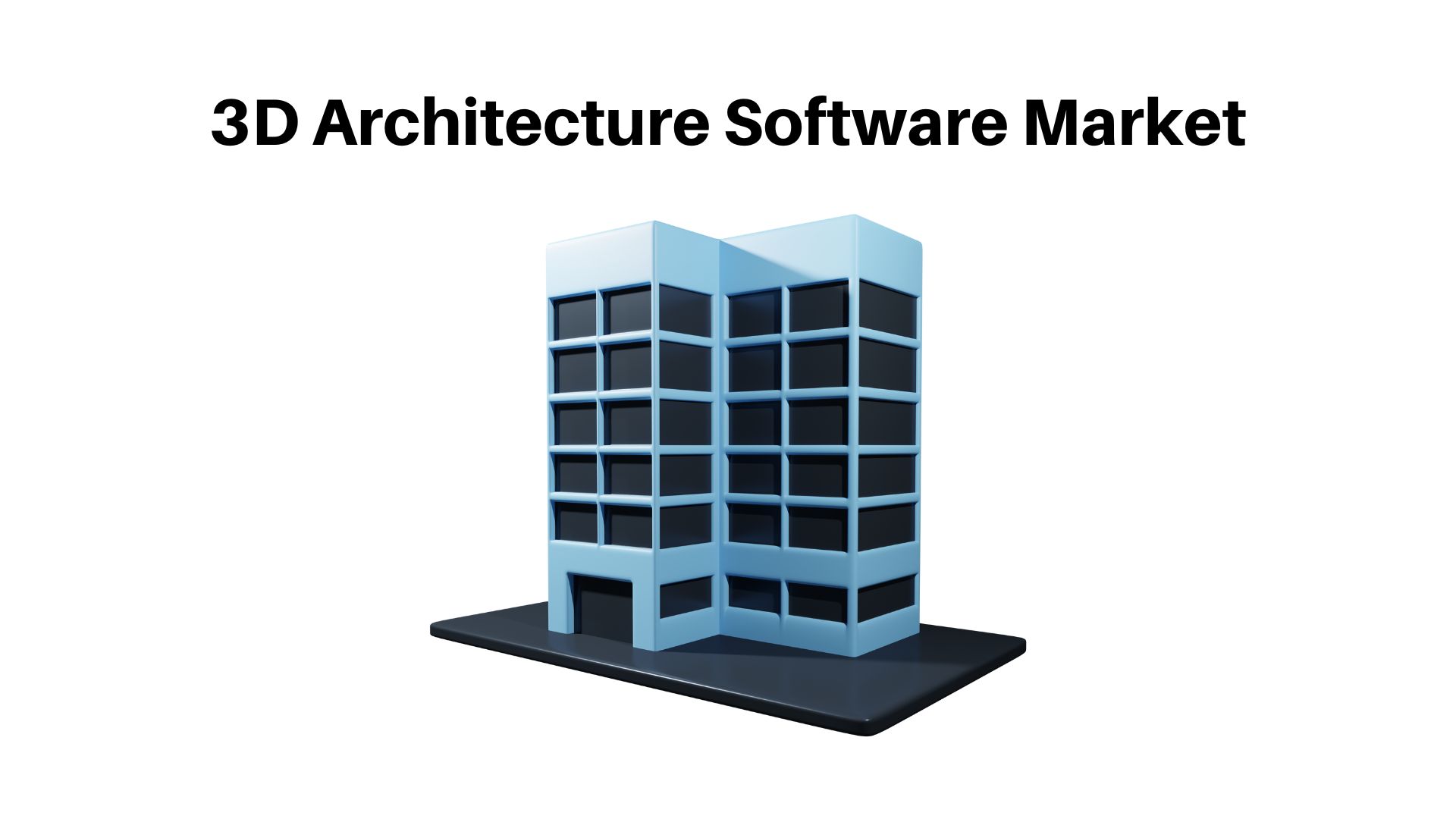3D Architecture Software Market Expected To Reach CAGR Value Of Over 12% By 2032

Page Contents
Market Overview
Published Via 11Press: The 3D Architecture Software Market size is expected to be worth around USD 7.7 Bn by 2032 from USD 2.5 Bn in 2022, growing at a CAGR of 12% during the forecast period from 2022 to 2032.
The 3D architecture software market is thriving and growing at a rapid pace in recent years. The advancements in technology have opened up new avenues for architectural design and visualization, leading to a surge in demand for 3D architecture software. With the rise of smart cities and sustainable development, architects and builders are increasingly adopting 3D software to create complex building designs that cater to the evolving needs of modern society.
One of the primary drivers of this growth is the increasing adoption of Building Information Modelling (BIM) technology across various industries. BIM-based tools offer detailed insights into building designs, including energy analysis, cost estimation, clash detection, and construction planning features that make it easier for architects and builders to create efficient buildings with minimal errors. It also enhances collaboration between multiple stakeholders involved in a construction project.
Request For Sample Report Here: https://market.us/report/3d-architecture-software-market/request-sample/

Key Takeaways
- Growing Demand: The 3D architecture software market is experiencing tremendous growth due to the rising need for 3D modeling and visualization tools in the architecture and construction industries. This demand is being driven by an increasing need for accurate 3D designs that help reduce errors and boost project efficiency.
- Technological Advancements: The market is continually developing, with new and advanced technologies being introduced to meet the specific requirements of this sector. These include features such as real-time rendering, virtual reality, and augmented reality that are aiding architects and designers in creating more immersive and interactive designs.
- Cloud-Based Solutions: Cloud-based solutions are becoming more and more commonplace in the 3D architecture software market, offering greater versatility and scalability compared to traditional on-premise options. This enables architects and designers to work together more efficiently on projects regardless of their location.
- Increasing Competition: With the rising demand for 3D architecture software, there has been an uptick in competition in the market with several established and new players entering it. This has given rise to new, creative solutions as well as price competitiveness within this space.
- Focus on Sustainability: Sustainability is becoming an increasingly important aspect of architecture and construction, which is reflected in the 3D architecture software market as well. Software vendors are creating solutions to help architects create sustainable designs with energy-saving features such as tools for simulating building performance and analyzing energy consumption.
Regional Analysis
- North America is expected to lead the 3D architecture software market due to the presence of major players such as Autodesk Inc., Trimble Inc., and Bentley Systems in the region. Furthermore, advanced technologies like virtual reality and augmented reality are seeing widespread adoption, fueling demand for 3D architecture software.
- Europe is a major market for 3D architecture software, with countries such as Germany, France, and the UK dominating sales. The region is seeing an increasing adoption of cloud-based solutions which is fueling market expansion.
- The Asia-Pacific region is expected to experience rapid growth in the 3D architecture software market due to the increased adoption of 3D modeling and visualization tools within construction projects. Countries such as China, Japan, and India are anticipated to be major driving forces behind this expansion within this region.
- The Middle East and Africa region is seeing an uptick in infrastructure projects, fuelling demand for 3D architecture software. Countries such as UAE, Saudi Arabia, and South Africa are expected to contribute significantly to market expansion within this region.
- The Latin America region is anticipated to experience moderate growth in the 3D architecture software market due to the increasing adoption of 3D modeling and visualization tools within construction projects. Countries such as Brazil, Mexico, and Argentina are anticipated to be major contributors to this growth within the region.
Drivers
- The architecture and construction industry is experiencing an uptick in demand for 3D visualization and modeling tools, which enable accurate and detailed designs. This trend is fueling growth within the 3D architecture software market. Technological Advancements, The market is experiencing constant technological advancements, such as real-time rendering, virtual reality, and augmented reality that enable architects and designers to create more immersive and interactive designs. This trend has resulted in the adoption of 3D architecture software by architects and designers.
- Growing Adoption of Cloud-Based Solutions, Cloud-based solutions are becoming increasingly popular in the 3D architecture software market due to their scalability, adaptability, and cost efficiency. This trend is driving market growth as architects and designers can collaborate on projects in real-time regardless of their location. Sustainability Gaining Relevance, Sustainability is becoming a more significant issue within the architecture and construction industry, prompting many to turn towards 3D architecture software that helps architects and designers create sustainable designs that save energy.
- Rising Demand for Building Information Modeling (BIM), BIM is becoming more and more commonplace in construction projects, as it facilitates better collaboration, reduces errors, and enhances project efficiency. This has resulted in the growth of the 3D architecture software market as BIM requires the use of 3D modeling and visualization tools.
Browse the summary of the report and Complete Table of Contents (TOC): https://market.us/report/3d-architecture-software-market/table-of-content/
Restraints
High cost of the software: The high price tag associated with 3D architecture software is a major barrier for the market, as it requires significant investments for small and medium-sized businesses. This has the potential to restrict adoption, particularly in emerging economies. The complexity of Software, 3D architecture software can be quite intricate and require extensive training to use efficiently. This could present a problem for smaller firms with limited resources, which may restrict their adoption of the program.
Lack of standardization in the industry can be a hindrance for businesses that rely on multiple software solutions, as it leads to interoperability issues between different programs. This poses an obstacle for firms that work with multiple programs because it leads to inefficiencies and errors. Limited Access to Technology In some regions, access to advanced technologies like virtual reality and cloud-based solutions may be restricted, which could put a brake on the market. This puts companies in an unfavorable position when trying to adopt 3D architecture software solutions that would otherwise boost their competitiveness.
Security Concerns, Cloud-based solutions may present security risks, particularly with sensitive project data. This has the potential to restrict the adoption of cloud-based 3D architecture software as many firms prefer to keep their information on-premise in order to reduce the risk of data breaches.
Opportunities
Growing Demand for Smart Cities The growing interest in creating smart cities presents significant opportunities for the 3D architecture software industry. 3D architecture software helps designers create detailed and accurate plans for infrastructure such as buildings, roads, and utilities within these smart city systems. Integration with Other Technologies, Combining 3D architecture software with other cutting-edge technologies like artificial intelligence and the Internet of Things (IoT) offers tremendous potential for the market. This combination allows architects and designers to craft more intelligent and responsive designs.
Emerging Markets Emerging economies such as India, China, and Brazil are experiencing remarkable growth in the architecture and construction sector. This presents opportunities for 3D architecture software vendors, as companies in these nations strive to stay ahead of competitors by adopting cutting-edge technologies. Use in the entertainment industry 3D architecture software can also be utilized in this sector to create virtual sets and 3D models for movies and video games, offering opportunities for market growth within this growing sector.
Education and Training The introduction of 3D architecture software into education and training can create opportunities for the market, as it helps develop the abilities of future architects and designers. This could potentially result in greater adoption rates of this type of software in the future.
Challenges
High Competition The 3D architecture software industry is highly competitive, with numerous players offering a variety of solutions. This can present firms with challenges when trying to stand out and gain market share. Need for Constant Innovation As the market continues to experience rapid technological advances, firms must keep up with them to remain competitive. This presents difficulties for smaller firms with limited resources.
Integration Issues Integrating 3D architecture software with other software solutions can present a challenge, particularly if they are incompatible. This could result in inefficiencies and errors during the design phase. Limitation of Adoption by Smaller Firms, Smaller architecture and design firms may be reluctant to invest in 3D architecture software due to its high cost and complexity, potentially restricting its potential market.
Resistance to Change, Resistance to change can present a challenge for the market, as firms may be reluctant to adopt new technologies and processes. This poses an especially large obstacle for companies that have been using traditional design processes for some time.
Report Scope
| Report Attribute | Details |
| The market size value in 2022 | USD 2.5 Bn |
| Revenue forecast by 2032 | USD 7.7 Bn |
| Growth Rate | CAGR Of 12% |
| Regions Covered | North America, Europe, Asia Pacific, Latin America, and Middle East & Africa, and the Rest of the World |
| Historical Years | 2017-2022 |
| Base Year | 2022 |
| Estimated Year | 2023 |
| Short-Term Projection Year | 2028 |
| Long-Term Projected Year | 2032 |
Key Market Segments
Type
- Linux
- Windows
- Others
Application
- Architects
- Contractors
- School
- Others
Key Market Players included in the report:
- Dassault Systemes
- Autodesk
- Trimble
- Graphisoft
- Bentley Systems
- Chief Architect
- Asynth
- Vectorworks
- SoftPlan Systems
- Elecosoft
- Cadsoft
- Abis Software
- Cedreo
- Zuken
- Encore Software
Frequently Asked Questions
What is the market study period?
The 3D Architecture Software Market is studied from 2017 – 2032.
What is the growth rate for the 3D Architecture Software Market?
The 3D Architecture Software Market is growing at a CAGR of 12%
Who are the major players in the 3D Architecture Software Market?
Dassault Systemes, Autodesk, Trimble, Graphisoft, Bentley Systems, Chief Architect, Asynth, Vectorworks, SoftPlan Systems, Elecosoft, Cadsoft, Abis Software, Cedreo, Zuken, Encore Software
The team behind market.us, marketresearch.biz, market.biz and more. Our purpose is to keep our customers ahead of the game with regard to the markets. They may fluctuate up or down, but we will help you to stay ahead of the curve in these market fluctuations. Our consistent growth and ability to deliver in-depth analyses and market insight has engaged genuine market players. They have faith in us to offer the data and information they require to make balanced and decisive marketing decisions.



